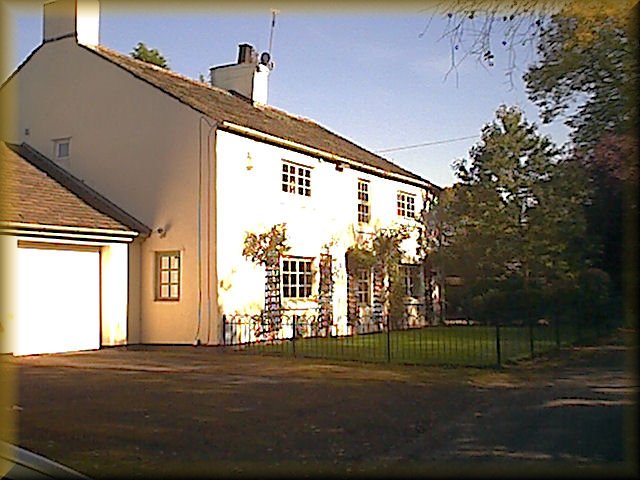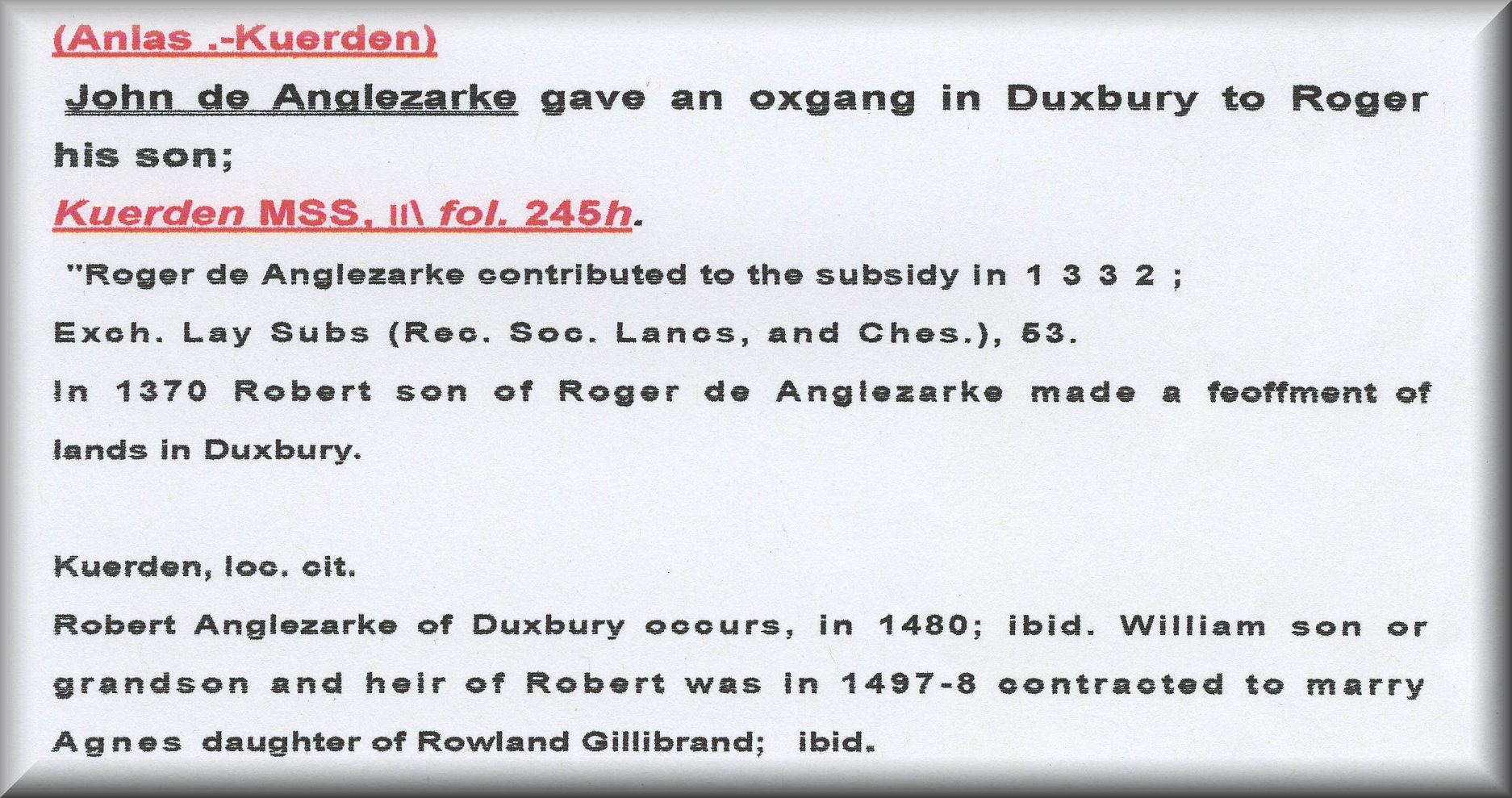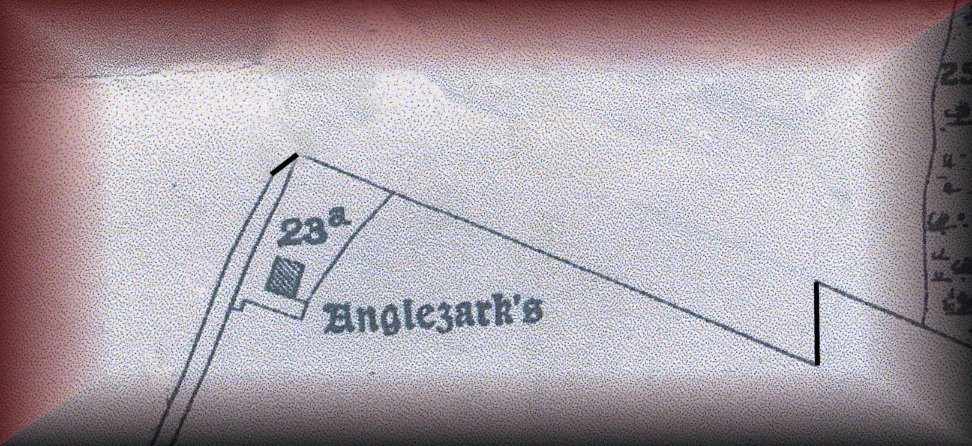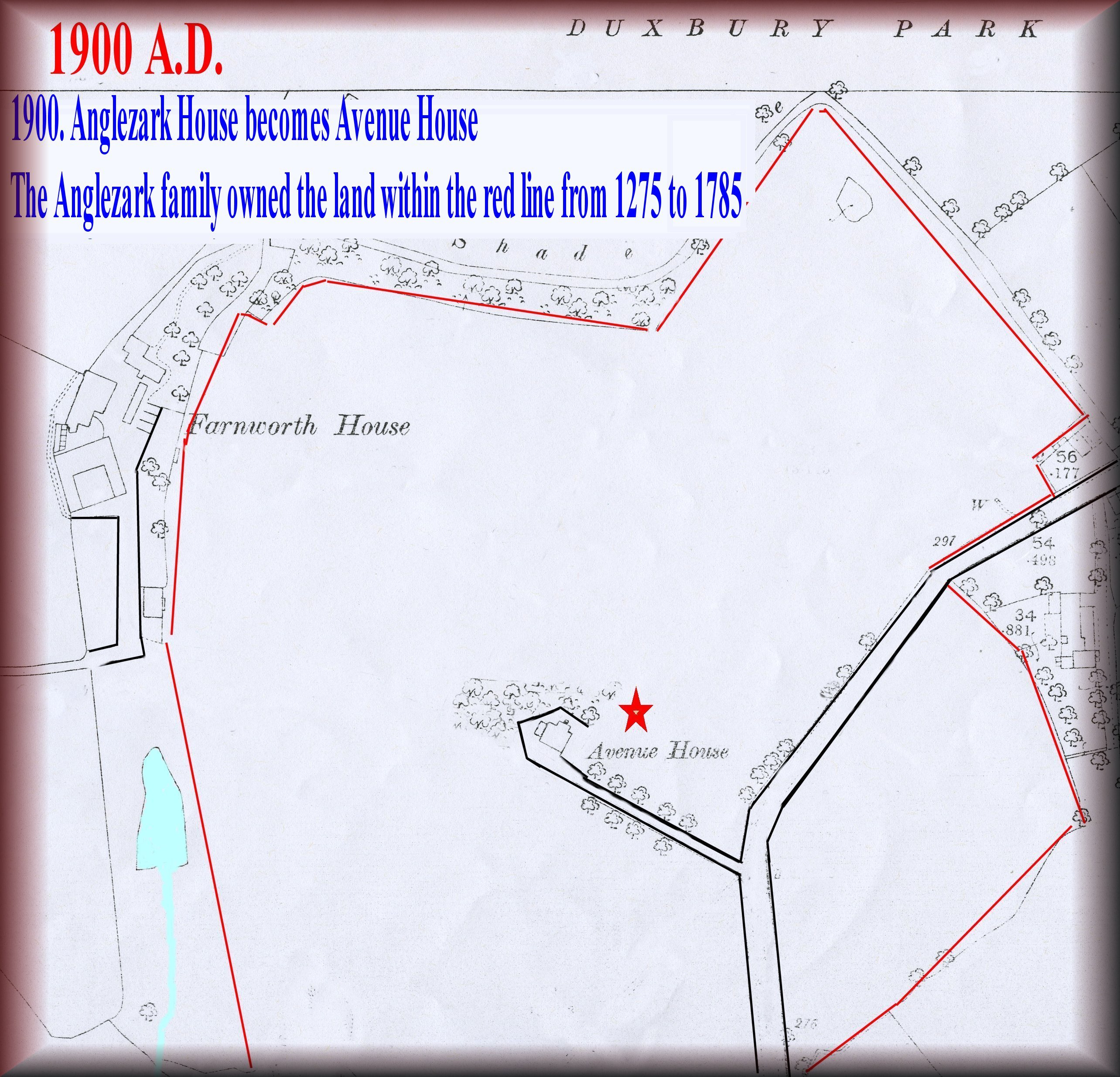Return to mylesstandish.info
Anglezark House - Manor of Duxbury.

Anglezark House - 2007.

1288 A.D.


1785 A.D.


1891 A.D.

In the great sale of the Duxbury Estate in 1891, Anglezark
House is described as Lot 23a - two cottages?

1900 A.D.

In 1900 the new owners of Anglezark House
changed the name (after 700 years) to Avenue House. In 1968 the house was
purchased by the Robinson family who renamed it “The Cottage” and this remains
the name in 2007.

1541 A.D.
DEED 228. A Standish of Standish
document relating to Elizabeth Anglezark widow of Anglezark House Duxbury.


Standish Deed Number 239 dated 20th August 17th year 1575 indicates that Anglezark House and lands were rented from the Standish of Standish family thus this part of the Manor of Duxbury was not the property of the Standish of Duxbury Family of the Pele Tower. - Webmaster
Standish of Standish Deed Number 239 dated 20th of August in the 17th year
of Elizabeth [1575]
Indenture [in
English], dated 20th August 17th year 1575
of Elizabeth[1575], between Edward Standyshe of Standyshe, esq., and Adam Hawarden of
Wolston [Wolston near Warrington], esq., by which it is agreed that Alexander
son of Edward shall many Elizabeth one of the daughters of
the said Adam. Edward agrees to convey to John Radclyfe, Richard
Bolde, Edward Norres, and William Hulton, all his manors, lands,
&c, to hold in trust. Those named in a schedule attached to
the deed, and worth yearly £22 13s. 4d., they are to hold to the use
of Edward Standyshe for his life, and on his death to the use of
Alexander Standyshe and Elizabeth, and their heirs male as one
part of her jointure.
The. said feoffees to be
also seised of the capital messuage and the chief house of Holt in Coppull and
the demesne belonging, which William Tatton and Mary his wife hold for the life
of Mary, reversion to the use of the said Edward during the life of Mary, with
remainder to the said Alexander and Elizabeth and their heirs, &c, in the
name of a full jointure to the said Elizabeth. And it is also agreed that the
said Edward Standish, esq., shall pay to the said Alexander and Elizabeth after
their marriage during his life the sum of £22 13s. 4d. yearly at the “ Mansion
House”of the said Edward called the Hall of Standish ; and that the feoffees
shall stand and be seised in all other the premises not limited in this
indenture, for the use of the said Edward with remainder to the said Alexander
and Elizabeth, their heirs, &c.; and that there shall be paid to the said
Alexander and Elizabeth during the natural life of Mary wife of William Tatton
the sum of £4, at the “ new mansion house “. There may be appointed and limited
out of the said feoffment so much of the premises other than the Hall of
Standyshe to the value of £44 yearly to Ellen now wife of the said Edward
Standish, esq., for term of her natural life, and for no other use or
purpose. He, the said Edward, may also limit the same for any other wife that
he may lawfully marry, for the sum of £30 yearly and no more. And ho may by his
last will and testament charge any of his estates not charged and limited as
above, with the sum of £200 to be paid within four years after his decease; and
may by will grant to any or every of his younger sons now living a rent charge
of 20 marks yearly, and to every younger son that may hereafter be born an
annual rent of 10 marks (£6 13s. 4d.), and to every servant an annual rent of
two marks (£1 6s. 8d.) and not more during their natural lives. But upon any
son being admitted, instituted, and inducted parson of the Church of Standyshe,
his annuity shall cease.
And it shall be lawful for
the said Edward Standyshe to grant leases for lives of any of the premises
except such as arc appointed for the use of the said Alexander and Elizabeth.
And if (which God forbid), Edward shall be taken prisoner in the Queen's
service, he may alienate land to the value of £10 per annum and no more for his
ransom. And if the said Alexander die without children by the said Elizabeth,
then she shall be paid by Edward Standish, esq., or his heirs, the annual rent
of 20 marks. The said Edward shall also entertain the said Alexander and
Elizabeth, with their issue, in the same house with himself, furnishing them
with one man and one woman servant, and with meat and drink and lodging honest
and competent for their degree. And if the said Edward should survive Ellen his
present wife, and if afterwards he should wed a second wife, and any disagreement
should happen to arise and grow between Edward and Alexander and his wife
concerning their keep, whereby Alexander and his wife shall depart from the
finding of Edward, then the said Edward shall pay to Alexander and Elizabeth 20
marks yearly in recompense. But if Alexander die before his father then Edward
is not bound to keep Elizabeth.
In consideration of the
said marriage Adam Hawarden agrees to convey all his estate in England and
Wales to the same trustees, to hold them to the use of the said Adam for his
natural life, and after his decease to the use of the said Alexander and
Elizabeth and the heirs of that marriage, with remainder to the right heirs of
the said Adam. Nevertheless it shall be lawful for the said Adam to appoint the
use of the chief mansion house and demesnes in Wolston, the mills, the "
turbary, mosse-mollo and mosse-roomes " [see note], the boons and the
accustomed averages rendered by his tenants, together with his fishing in the
water of Mersey, for the use of Alice his wife for the term of her natural life
in name of her jointure, without any remainder over to any other use. With a
further limitation of £20 yearly to any other wife he may chance to marry after
the death of the said Alice, for her life; and that any such wife after Alice
and after his decease shall pay yearly to Anne wife of John More,
esq., the sum of £8 17s. 8d. yearly for term of her natural life; and that he
may charge the-same estate with the sum of £40 to be paid within four years
after his decease for the purposes defined in his last will. Adam Hawarden may
also grant the following annuities: to his daughter Anne £10; to his daughters,
Margaret, Ellen, Isabel and Clemence, each, £6 13s. 4d.; to his brother William
Hawarden, 33s. 4d., and to two servants not more than 26s. 8d.
The schedule attached to
the deed gives a list of messuages on which Elizabeth's jointure is to becharged.
In Standyshe and Langtre: Roger Prescott, 33s. 4d.; Wyllyam Tayleor,5s. 9d.; wife of Gilbert Whalley, 6s. 8d.; Roger Brownlow, 20d.; Elizabeth
Haughe, 12d.; John Joley, 32s.; Richard Brokesmothe, 12d. ; Thomas Hyltone,
20d. ; Robert Brown-lawe, 14s. lOd.; Hugh Eyes, 2s. 8d.; Richard Lathome, 2s.;Thomas Martone, 12d.
Coppull and Worthington : Humfray Nyghtgalle, 23s. 4d.;Ollyver Tayleor, 13s. 4d. ; wife of William Holte, 7s. lOd.; Gilbert Fydler,
4s. 4d.; Hugh Smythe, 6s. 8d.; James Nyghtgalle, 15s.; Robert Dycconson, 3s.;
Rauffe Giller [Gidlow], 9s.; wife of Alexander Hollyns,
Duxbury and Adlington: John Kyndesleye, 22s.; - wife of Robert Anlezarghe, 5s.lOd.;
Thomas Norres, 16s.; Thomas Rothwell, 27s. 8d.
Chorley and Heth Charnock: RychardeToogood, 2s.; Robert Waringe, 21s.;
Myles-Nyghtgale, 4s. Blackrodde andHyndley: Thomas Mark-lande, 33s. 4d.; Rycharde Woode, 12s.; James Catterall,
3s. Wygann : Alexander Foorthe, 16s.; James Kydde, 31s. 5d. ; wife of Hamon
Atherton, 23s. 4d.; Laurence Felle, 3s. 4d.; Henry Langeshaughe, 8s.; AlexanderBuckeley, 3s. 4d.; Wyllyam Brockesmouthe, 20d. (?); John Rygbye, 3s. 4d. ^
The capital messuage of Holte, £4(?).
Sum total, £26 13s. 4d.(?) These figures arepartly conjectural (and based on the £22 13s. 4d. and £4 given in the deed),
for the schedule is illegible in places. Witnesses endorsed on deed: Thomas
Lathom, William Hyde, George Lathum, Gylbert Rygbye, priest, Thomas Molyneux.
This is the largest deed in the series, consisting of two sheets, 25 X 23, with an
attached schedule, 10J X 5J. Signed, by Adam Hawarden. Seal gone.
Earwaker,
CCCXXVI. Following Fr. West's abstract, he has transcribed " Cotton"
in error for Tatton. The chief house of the Standishes in Coppull was The Holt,
(see Standish Deed No.215). It was held in dower by a Standish widow married to
William Tatton. For Mary Tatton and
the other parties in the deed, see History of
Standish, pages 137-139. “ Mosse-molle “ Molle or mull generally means dust
or pieces. The word is related to “mould.” Here it seems to signify the peat
already dug out in distinction to that which is still in the moss rooms or
places. Walkden in his Diary, 9th July, 1729, says, “ I
sodded the turf stack top, and dressed the mull from beside it”.
- Webmaster


![]()

![]()

![]()

![]()

![]()

![]()